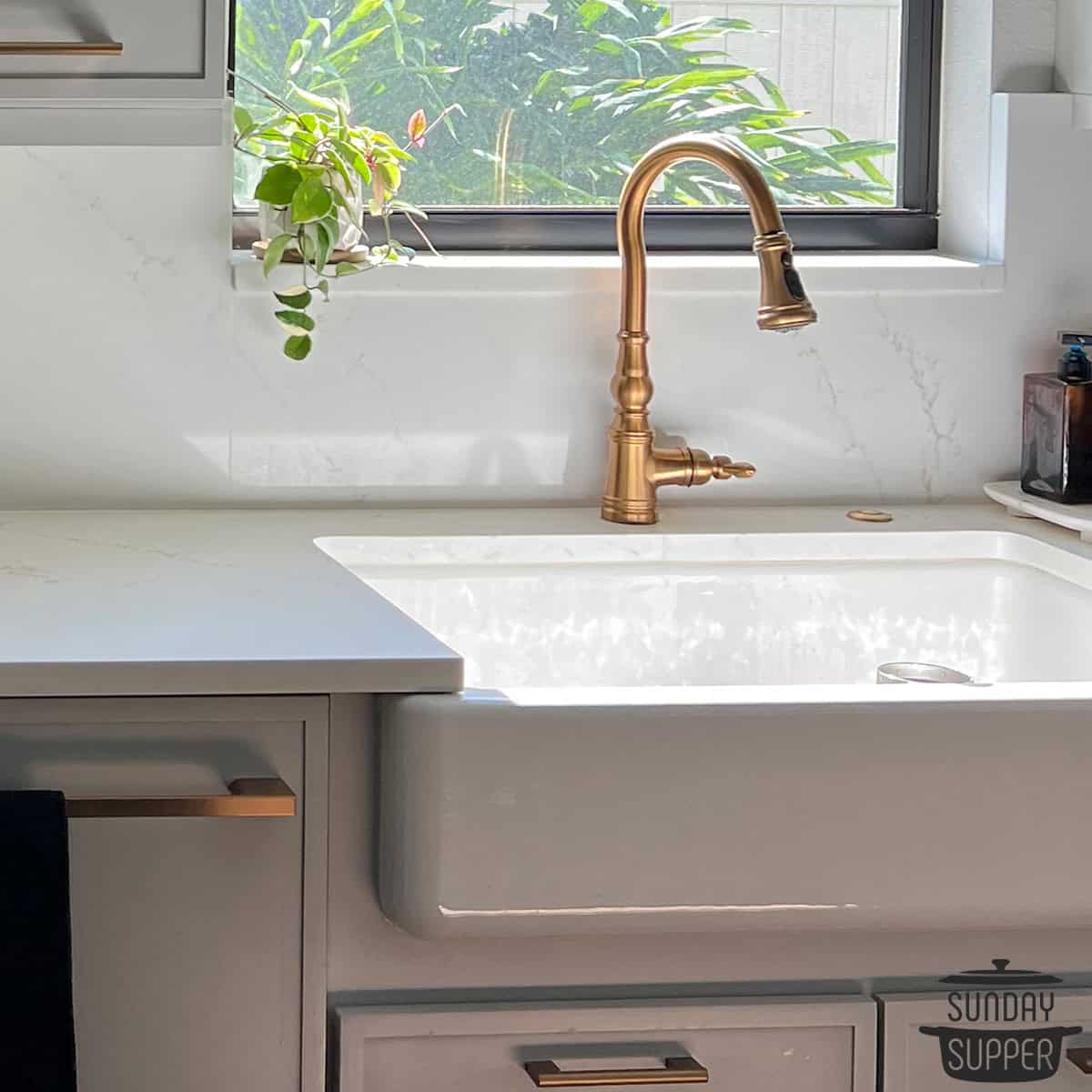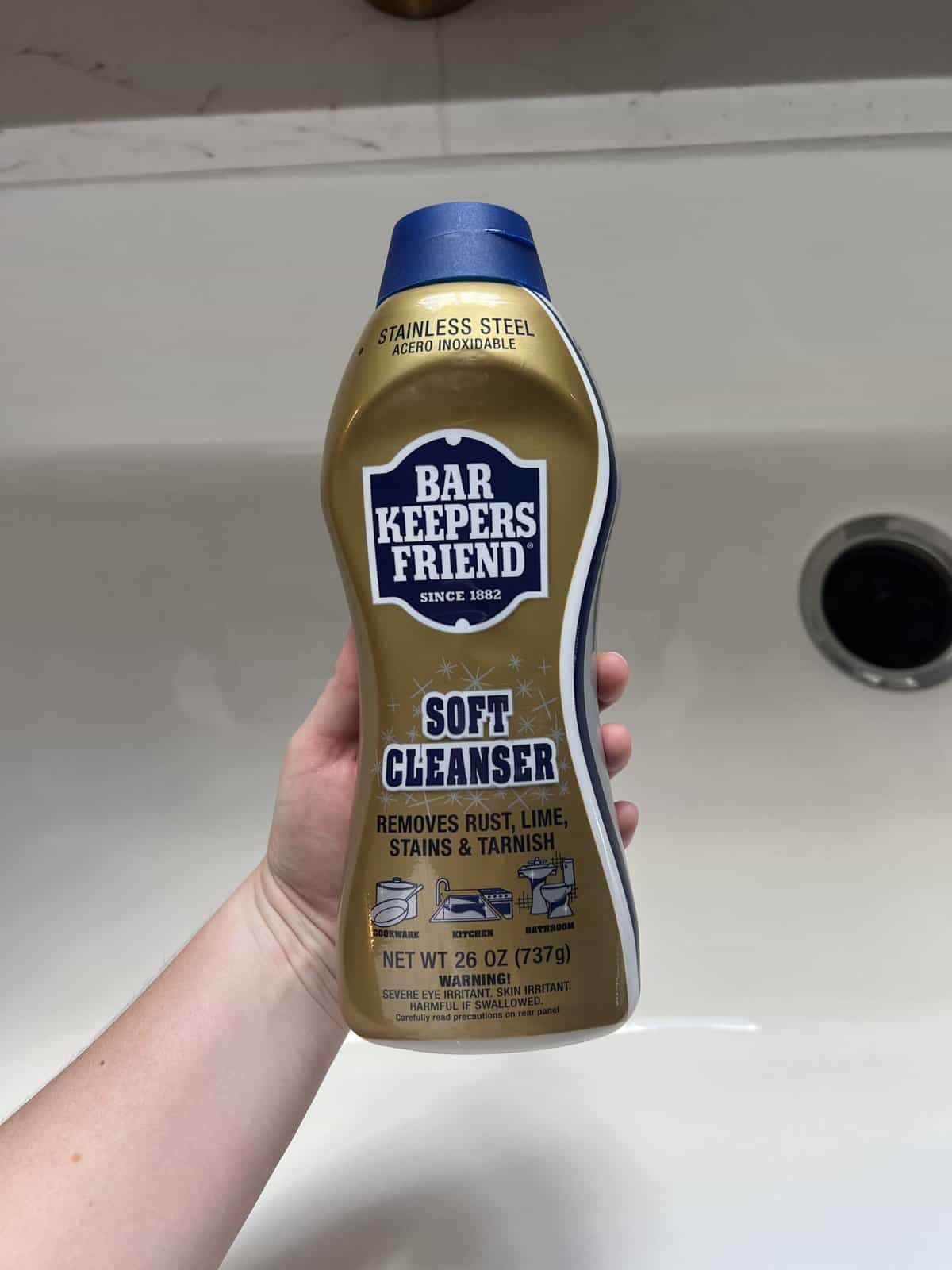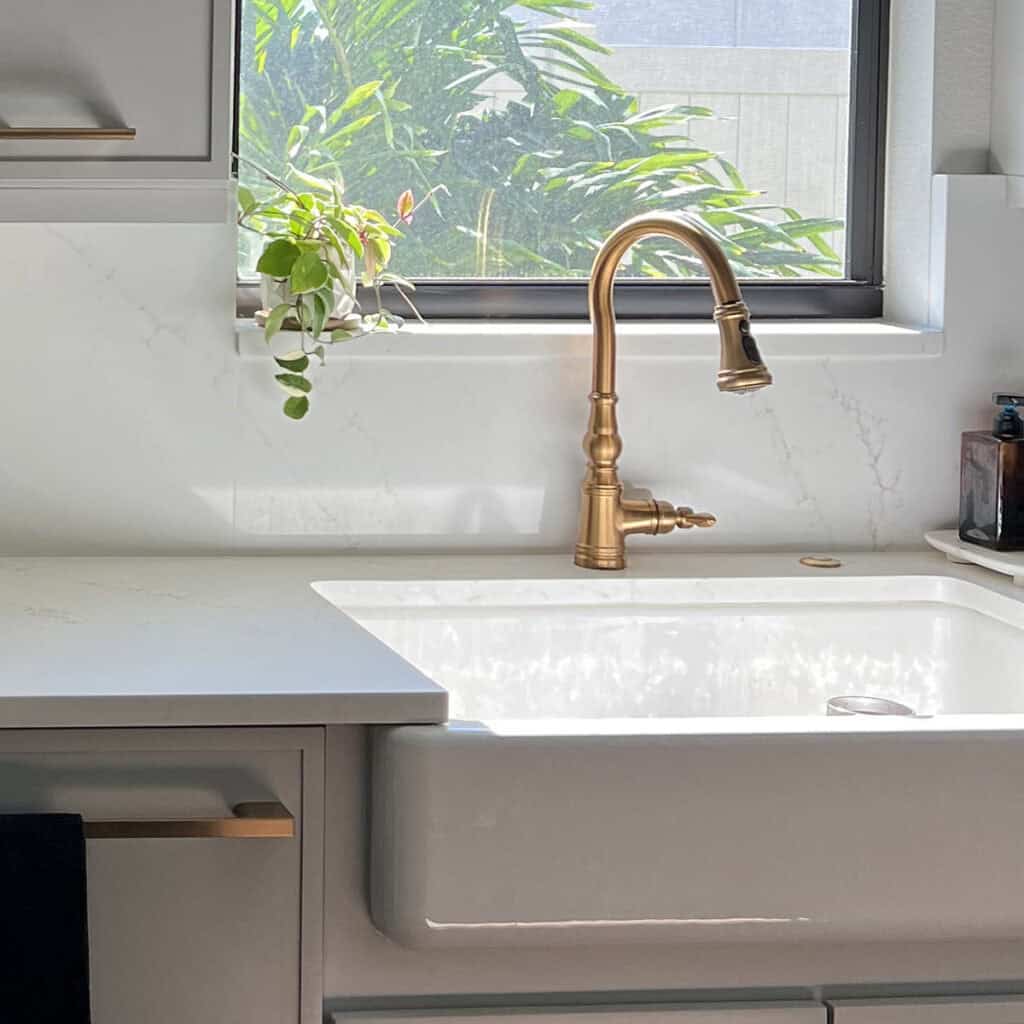This post may contain paid links. If you make a purchase through links on our site, we may earn a commission.
Keep your kitchen clean, tidy, and free of germs and bacteria with my expert guide on How to Clean a Kitchen Sink! Complete with every type of sink and which cleaners and tools are safe to use with them, including porcelain and copper. Plus, a guide on how to clean a garbage disposal!

Jump to:
- Cleaning a Kitchen Sink
- Isabel's Porcelain Sink
- What Not to Use to Clean Sinks
- Needed Tools for Cleaning a Sink
- Kitchen Cleaning Tools
- How to Clean A Stainless Steel Sink
- How to Clean a Ceramic Sink
- How to Clean a Porcelain Sink
- How to Clean a Copper Sink
- How to Clean a Garbage Disposal
- Cleaning Kitchen Sink Tips
- Kitchen Sink Cleaning FAQ
- How-to Guides
- Reviews
Cleaning a Kitchen Sink
It's been a dream of mine for as long as I've had my own kitchen to install a porcelain sink. They're gorgeous and remind me of a show kitchen! I could perfectly envision myself it, and was so excited the day I finally achieved my goal.
My excitement died down a little when I quickly discovered that I had no idea how to clean a porcelain sink. I was so excited, but it turns out this darn sink scratches so easily if you're not careful! You can't use the same cleaning materials on every type of sink.
After I realized this, I'll admit I went down a cleaning rabbit hole. I'm proud to say that as a result of the effort I put into learning the best way to clean a sink (including the faucets and drain), I have plenty of tips and tricks to share with you!
What Not to Use to Clean Sinks
No matter what type of sink you're cleaning, there are a few typical household cleaning tools you should avoid using for the job:
- Magic Erasers: While they're absolutely magic in so many ways, magic erasers are also very abrasive and can damage the finish on many materials, especially those with a shine to them. Kitchen sinks can turn dull and scratch by using magic erasers, regardless of the material.
- Hard Bristle Brushes: Despite how they might look, most sinks are quite easy to scratch, especially while using powerful cleaners. Make sure any brushes are soft-bristled, such as a toothbrush. Keep your hard-bristle brushes away from your sink!
- Steel Wool: Never touch a sink with steel wool! While steel wool is a very useful tool for cleaning cast iron, sinks are too delicate.
- Abrasive Cleaners: Washing soda, coarse salt, and some chemical cleaners are far too coarse and hard for many types of sink. They can wear away the finish, leaving the sink even more scratched than before.
Needed Tools for Cleaning a Sink
- Microfiber cloth: The most important tool when cleaning a sink is a good microfiber cloth. It serves as a sponge and soft cloth at the same time, and the tiny fiber size means that it'll do a lot better getting stains out than a regular kitchen towel.
- Baking soda: Baking soda is pretty much magic when it comes to cleaning. It's a very mild abrasive that doesn't scratch most surfaces, but it's still strong enough for stubborn stains and works especially well on getting rid of bad odors.
- Warm water: I recommend having a dish of warm water set aside for cleaning. You can add little bits of baking soda to make a paste, or dip a brush or cloth in it, without risking washing away all your cleaner in the sink.
- Dish soap: I highly recommend a mild, grease-cutting dish soap. I've always used Dawn soap, as I find it does a very effective job on grease and doesn't leave any stains.
- White Vinegar: Unless you're cleaning a copper sink, you'll want some vinegar. It works great on drains!
- Optional: Lemon slices, bleach
All of these cleaners are great to have on hand, and will do the job well. But if you want a true magic cure-all, I cannot recommend enough getting some Bar Keeper's Friend! It's the hero of my kitchen and works like a charm on completely blackened cookie sheets, charred residue on Dutch Ovens, and more.

Kitchen Cleaning Tools
| Sink Material | Cleaners to Use | Cleaners to Avoid |
|---|---|---|
| Stainless Steel Sink | Dish soap Baking soda Bar Keeper's Friend | Bleach Abrasive cleaners Scrub brushes Strong acids |
| Ceramic Sink | Dish soap Baking soda Bar Keeper's Friend Lemon & Salt | Abrasive cleaners |
| Porcelain Sink | Bleach Baking soda Dish soap Bar Keeper's Friend Hydrogen Peroxide | Abrasive cleaners |
| Copper Sink | Dish soap | Bleach Sponges Scrub brushes Abrasive cleaners Vinegar |
How to Clean A Stainless Steel Sink
1: Apply Baking Soda
Clear out any dishes, then spray water on the sink, trying to cover the entire surface. Sprinkle about ½ a cup of baking soda over the wet surface.
2: Scrub with Soap
Wet down a sponge or microfiber cloth with warm water, then add dish soap. Gently scrub the sink in a circular motion, pushing any grime into the drain as you go.
3: Clean Details
Using a tooth brush or other soft-bristled brush dipped in soapy water, gently scrub the details of the sink such as the drain cover, lip, and faucet.
4: Rinse and Dry
Rinse the sink down with clean water, and dry off with a fresh, clean microfiber cloth. (Using microfiber will reduce any leftover water spots!)
Cleaning Stainless Steel Sinks
Stainless steel sinks are pretty easy to scratch or turn cloudy. Make sure to be gentle on them, and only give them a more vigorous scrub when a stain really won't come out. For the most part, just wiping down a stainless steel sink once at night will keep it looking beautiful.
How to Clean a Ceramic Sink
1: Wet Sink
Remove all dishes. Then, using a wet cloth, wipe down the sink. You want to avoid spraying water on a ceramic sink as the porous surface can easily get too wet for proper cleaning.
2: Add Baking Soda
Sprinkle about ½ a cup of baking soda over the surface of the sink, including the faucet and handles, and let sit for a few minutes.
3: Scrub
Using a soft non-scrubby sponge or a soft-bristled scrub brush, gently scrub clean the sink. If you need more cleaning power, spray the sink down with hydrogen peroxide or use Bar Keeper's Friend.
4: Rinse & Dry
Rinse the sink down with clean water, then wipe it dry with a microfiber cloth.
Cleaning Ceramic Sinks
Ceramic sinks can get rust spots much more easily than stainless steel, and are prone to losing their shiny coating if scrubbed too vigorously. Be extra careful with your ceramic sink and make sure to clean it out daily.
How to Clean a Porcelain Sink
I learned the hard way that porcelain sinks and their beautiful white shine take a lot of work to keep clean. Keep on top of any stains by cleaning them up right away- but try to avoid brushes! Instead, I've found that just a lemon and some salt work even better.
1: Scrub out rust
First, remove the rust. I like to do this by applying large-grain salt (such as Kosher salt) to a slice of lemon, and using it like a natural scrub brush. Only scrub rust spots!
2: Rinse & Wet Sink
Rinse off the sink, then wipe it down with a wet towel. You want it damp, not dripping wet. Apply ½ cup baking soda and spritz with hydrogen peroxide.
3: Gently Scrub Sink
Using only the soft side of a clean sponge, gently scrub the sink clean. You can also use a microfiber cloth.
4: Rinse & Dry
Rinse the sink dry with warm water, then wipe dry with a microfiber cloth to remove any water spots. Optional: Give it a nice shine with a few drops of oil of choice- I like lemon oil!
Cleaning Porcelain Sinks
Take it from me: porcelain sinks stain quickly and scratch easily! You'll want to be on top of keeping your sink clean and make sure to quickly wipe it down at least every night, but preferably after each meal.
How to Clean a Copper Sink
If you're lucky enough to find yourself with a copper sink, you'll likely discover how hard they are to keep clean without damaging them! Copper is a delicate, soft metal that dents easily and discolors quickly. To protect your copper sink, clean it out regularly (I recommend at least drying it daily) and never use any cleaner stronger than dish soap!
You'll also want to avoid letting dishes sit in a copper sink, as any leftover food with a high acid content or staining ingredients can quickly stain the surface.
1: Apply Soapy Water
In a small bowl, mix warm water and dish soap. Soak a very soft kitchen cloth in the soap water and wipe down the sink with it.
2: Gently Wipe Sink
Only using a cloth and never any other scrubbing tool, wipe down the sink using a circular motion on any stuck-on stains. Never scrub your copper sink!
3: Wipe Faucet
Wipe down the faucet and handles, which must be cleaned with the same gentle methods as the sink tub.
4: Rinse & Dry
Rinse the soap off, then wipe down the sink with a microfiber cloth until completely dry.
Cleaning Copper Sinks
Copper sinks are gorgeous, but very delicate. The soft metal is easy to dent, and anything abrasive can easily destroy the natural patina of the metal. I highly recommend giving copper sinks a complete wipe-down and dry every night.
How to Clean a Garbage Disposal
Technically, this works for how to clean a sink drain no matter if you have a garbage disposal or not! Just skip the last two steps if your drain doesn't have a garbage disposal.
For extra convenience, you can freeze ice cubes with lemon peels inside of them and use them as quick and easy disposal cleaners! Just don't include any seeds or stems, as they don't break down well in the disposal.
1: Flush the Drain
Remove the drain cover, and run the garbage disposal if present. Then pour a pot or kettle of boiling water down the drain, pouring slowly and evenly. This removes surface food particles and starts breaking down grease and oil.
2: Add Baking Soda
Pour ½ a cup of baking soda down the drain, then let it sit for at least 5 minutes. This will help it absorb any nasty drain odors.
3: Add Vinegar
Pour 1 cup of white vinegar down the drain, and let it bubble up for 15 minutes. If you've got a clogged drain, you can let it sit as long as half an hour to break down debris.
4: Flush Again
Boil another pot or kettle of water, and then pour it down the drain to wash out the baking soda mixture and vinegar.
5: Add Ice & Salt
If you have a garbage disposal: Add a handful of ice cubes, 1-2 Tablespoons of kosher or flake salt, and lemon peel (optional) to the garbage disposal, and run until it's clear.
6: Rinse
Add a little dish soap to the disposal, then run the disposal while the faucet is on for a final rinse.
How Often to Clean a Garbage Disposal
If you have a garbage disposal, make sure to give it a good clean every month. If your kitchen sink doesn't have a disposal, I recommend cleaning the drain trap monthly and flushing it out with a drain plunger to ensure it's completely clear.
Cleaning Kitchen Sink Tips
- It's a good idea to give your kitchen sink a thorough cleaning at least once a month, but I recommend twice a month if you cook often, especially if you often cook with raw meat.
- If you find you're having a problem with fruit flies in the sink, make sure to clean the garbage disposal out! They're drawn to the crevices of disposals, so be sure to clean it out well.
- If anything is stuck in the disposal, make sure to unplug the garbage disposal entirely before reaching into it.
- If a stain just won't come off, a little toilet bowl cleaner can get pretty much anything clean. But make absolutely sure it doesn't have a strongly colored dye! I've found that dark colored cleaners can stain porcelain and ceramic, even when they're labeled for cleaning those surfaces.
- If you're cooking with curry powder, turmeric, or food coloring, keep cleaner on hand! Even a minute of contact with a white surface will leave a stain.
Kitchen Sink Cleaning FAQ
I recommend cleaning sinks with baking soda twice a month if you do a lot of home cooking. Remember to clean out all the nooks and crannies! For most sinks, you can use a soft toothbrush on the detailing.
While commercial cleaners for cleaning garbage disposals exist, I prefer to use a mixture of baking soda, vinegar, hot water, salt, and lemon peels. The salt and peels will scrub the surfaces of the garbage disposal as well as give it a nice fresh smell, and the peels are loaded with lemon oil that helps repel soap scum. Baking soda and vinegar help break down grease and reduce odors.
Yes, you should always disinfect the sink after raw meat has come in contact with it! The best way to do this is with commercial disinfectant cleaners. Spray the sink down, then let the cleaner soak for a little bit before wiping down all surfaces including drain traps. Make sure to run the garbage disposal as well!
Have favorite ways to keep your kitchen clean? I want to hear about it! Bar Keeper's Friend was a recommendation from a friend that changed my life, so I'd love to hear what you rely on! Leave a comment below!
And keep an eye out for my series on how to keep a beautiful kitchen, like my guide on cleaning smelly microwaves or browned dutch ovens- no matter how busy your schedule!



Comments
No Comments